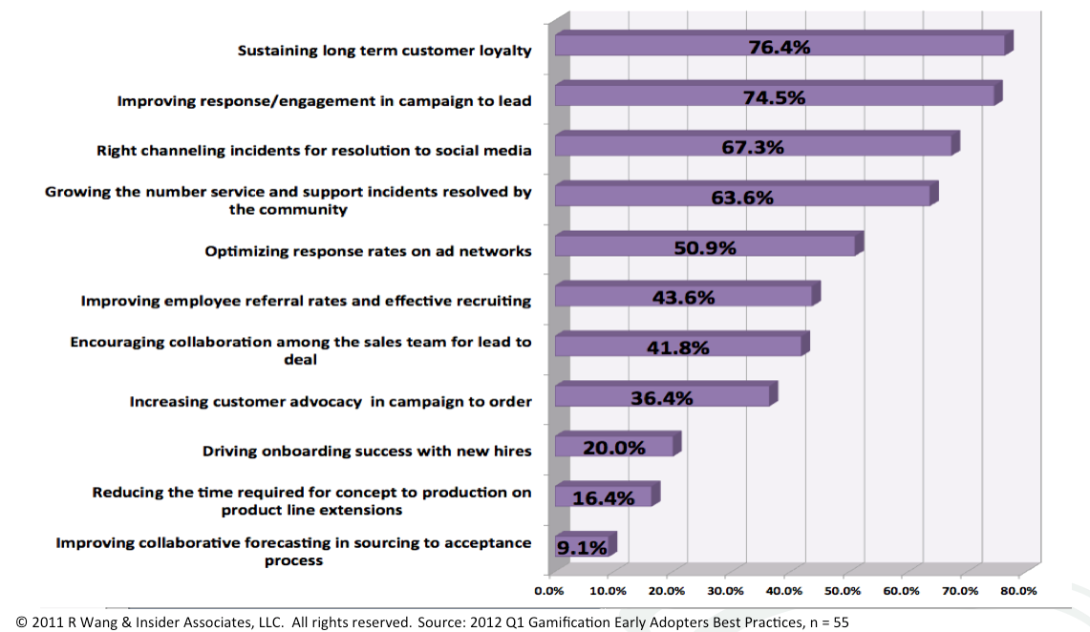
Research Summary: Demystifying Enterprise Gamification For Business

Purpose and Intent
Much hype surrounds the topic of gamification. Often seen as a technique to add engagement to existing tasks, projects, marketing campaigns, and initiatives, the term gamification unfortunately lacks the seriousness it deserves. This report seeks to change the point of view and demonstrate where gamification plays a role in the enterprise. More importantly, executives will discover how gamification can drive behavior and outcomes through both monetary and non-monetary incentives in enterprise class settings.
Executive Summary
Gamification describes a series of design principles, processes and systems used to influence, engage and motivate individuals, groups and communities to drive behaviors and effect desired outcomes. Originating from the video game industry, many of these pioneering concepts now play a key role in driving incentive and behavior management for both brands in the consumer world and internal scenarios in the workplace. Enterprise gamification is a user experience (UX) and consumerization of IT (CoIT) trend that will take the market by storm in 2012. Constellation believes that by 2013, more than 50 percent of all social business initiatives will include an enterprise gamification component.
In interviews with 55 early adopters of enterprise gamification, Constellation identifies the three core pillars that include measurable action, reputation and incentives. By creating triggers through both monetary and non-monetary incentives among customers, employees, partners, suppliers and other interested parties, organizations can secure sustainable engagement and drive business outcomes such as improved marketing response from external communities, sustained long-term customer loyalty, increased collaboration among internal teams, or enriched onboarding, delivering success with new hires, partners, and customers.
Enterprise gamification requires an application of psychology and behavioral economics to incentivize outcomes. Because enterprise gamification maps closely to human behavior, organizations will want to follow Constellation’s best practices in appealing to the “Seven Deadly Sins” for gamification design.
Research report surfaces leading practices from 55 early adopters
Some highlights of the report include:
- Details on who's using gamification across the enterprise
- The three pillars of enterprise gamification
- The six elements of sustainable engagement
- Sustainable behaviors to drive desired business outcomes
- The Seven Deadly Sins to Optimize Gamification Design
- The top gamified business processes for the enterprise (see Figure 1)
Figure 1. Marketing, Customer Service and HR Processes Lead in Gamified Processes

Your POV.
Designing your gamification models? What enterprise business processes will you gamify first? next? Ready to turbo charge your next generation customer experience? Have you tested out iActionable, CrowdTwist or the 3B’s (i.e. Badgeville, Bigdoor, and Bunchball? Ready to here how you can apply the white arts of the 7 Virtues to work? Add your comments to the blog or reach me via email: R (at) ConstellationRG (dot) com or R (at) SoftwareInsider (dot) com.
Reprints
Reprints can be purchased through Constellation Research, Inc. To request official reprints in PDF format, please contact sales (at) ConstellationRG (dot) com.
Get the report and other great research on the Constellation site
Resources and Related Posts
20110824 News Analysis: Bunchball Gamifies Salesforce.com And Delivers Simplified Applets
20110223 Best Practices: Applying The Seven Deadly Sins To Successful Gamification
20110120 Trends: 5 Engagement Factors For Gamification And The Enterprise
Community Input
Thanks to the following individuals for their review, input and contributions as part of the broader enterprise gamification community.
David Buckholtz (@dbuckho) - VP, Divisional CIO, Corporate IT, Sony Pictures Entertainment
Yvette Cameron (@yvettecameron) – VP & Principal Analyst, Constellation Research, Inc.
Andrea Chin – Senior VP, Transformation Office, Citigroup
Kris Duggan (@kduggan) – CEO and Co-Founder, Badgeville
Richie Etwaru (@richieetwaru) - Director, Chief Technology Officer's Office, UBS
Irvin Fain (@ifain) – CEO and Co-Founder, CrowdTwist
Frank Falcone (@frankcrm) – Co-Founder and Executive Program Director, Rotman Centre for CRM Excellence
Maggie Fox (@maggiefox) – Founder and CEO, Social Media Group
Paul Greenberg (@pgreenbe) – Founder and President, The 56 Group
Ben Haines (@benlhaines) – CIO, Pabst Brewing Co.
Peter Kim (@peterkim) – Managing Partner, Dachis Group
Esteban Kolsky (@ekolsky) – President, ThinkJar, LLC
Marshall Lager (@lager) – Founder and Managing Principal, Third Idea Consulting
Alan Lepofsky (@alanlepo) – VP & Principal Analyst, Constellation Research, Inc.
Rajat Paharia (@rajatrocks), Founder and Chief Product Officer, Bunchball
Emanuele Quintarelli (@absolutezubzero) - Partner and Social Business Strategist, Open Knowledge
Alistair Rennie (@alistair_rennie) – General Manager Social Business, IBM
Ted Sapountzis (@sapountzis) - VP Social Media Audience Marketing, SAP
Adam Sold (@kafuchale) - Senior Director of Strategy, Dolby Labs
Dilip Soman (@dilipsoman) - Professor of Strategy, University of Toronto Rotman School of Management
Keith Smith (@chiefdoorman) – Chief Doorman and CEO, Big Door
Josh Weinberger (@kitson) – Independent Analyst
Michael Wu, PhD (@mich8elwu) – Principal Scientist, Lithium Technologies
Disclosure
Although we work closely with many mega software vendors, we want you to trust us. For the full disclosure policy, stay tuned for the full client list on the Constellation Research website.
Copyright © 2011 R Wang and Insider Associates, LLC All rights reserved.
 R "Ray" Wang
R "Ray" Wang R "Ray" Wang
R "Ray" Wang